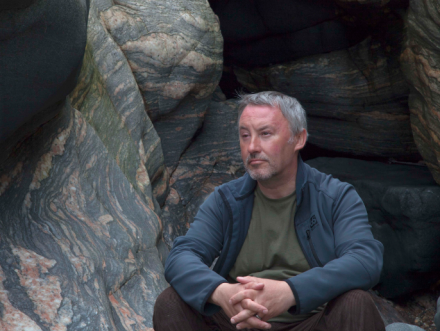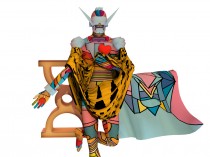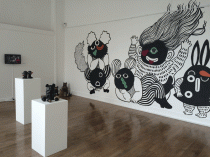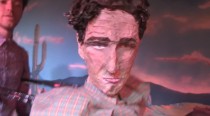
Matthew Dalziel is a visual artist who works in collaboration with Louise Scullion. Their studio creates artworks in photography, video, sound and sculpture that explore new artistic languages around the subject of ecology. These are Matthew’s his first five jobs.
_
1 Turner and Miller with The National Coal Board
My first real job after leaving school lasted six months and it was an apprenticeship as a Motor Mechanic. I can remember how cold it was working under the cars in a leaky, drafty, oily garage especially in winter. I left this job as I was accepted on as an apprentice Turner and Miller with the National Coal Board which became British Coal. I served my four-year apprenticeship and worked another three years as a time served worker. Working for the National Coal Board was supposed to be a job for life but the collisions that took place between Thatcher and Scargill made it clear that the industry was on its knees, it was obvious there was no long term future in the form that the community that I came from would recognise, in many ways it was this that created the impetus for me look further afield, so I attended night classes locally got some highers and applied successfully to Art College.
2 Salvesen Pea Factory
During the four years of my art school training I worked at various job but the most memorable of these was at the Christian Salvesen Pea Factory, I can honestly say this was the hardest physical work I ever took on! My then flat mate, Iain Nicoll, who was studying engineering at Dundee and now runs a very successful Alternative Energy Business worked there every summer, it was both tedious and relentless, I still can’t look at a frozen pea without feeling the burn of the rake we had to use to coax pods into the shelling machine. Ian and I now meet annually to go trout and salmon fishing, he insists on accompanying every meal with… peas.
3 Co Director of Image & Installation
My Art School training took me to Dundee, then Newport in Gwent Wales and finally to Glasgow School of Art. Leaving Art School can be a tricky time because momentum can be lost and friends and allies may go their separate ways. I was fortunate that I made some really close friends and we pulled our ideas and energies to come up with some schemes and plans to keep afloat. I graduated in 1989, which was just before Glasgow’s year as European City of Culture. Myself, Stevie Hurel and Oladele Bamgaboye thought that if we got together and formed an organisation or group we might have a better chance of accessing funding from both The Scottish Arts Council (now Creative Scotland) and also the many companies who wanted to get involved in the year of culture.
Our blue sky, or grey sky thinking it was Glasgow after all, mainly took place in two sorts of venues, a nice restaurant if we had any cash (Olly was a bit of a foodie) but mostly in the pub. We came up with some ideas and managed to write and present them competently enough to persuade The Scottish Arts Council to part with a healthy sum of cash and many local venues and companies donated their spaces, electrical kit, high fi gear, catering etc. For this they all received advertising in our brochures, invites etc and their friends all came along to the various openings and events. This taught me two things firstly that I enjoyed working in collaboration with others and secondly if you approach someone or some company, business etc with a good idea they might actually support it.
4 Artist in Industry with Shell
Image & Installation like all bright stars shone fiercely for a short period of time basically when the 1990 year of culture ended and we all went our separate ways. What to do next? The Scottish Arts Council’s news letter was my first port of call when looking for interesting opportunities and I saw advertised four one year long posts as Artist in Industry. This was brilliant for me as my previous experience as a Motor Mechanic and Turner and Millar was very useful at the interview and the Image & Installation documentation proved my artistic capabilities. I managed to secure one of the posts and moved to Peterhead in the north east coast of Scotland to work at the St Fergus Gas Plant. This was a brilliant experience, if a bit lonely, as I was the only artist among hundreds of engineers and oil workers (they called me ‘Picasso’!). It introduced me to this part of Scotland and I had access to images and material that no other artist had access to. I made a body of work there, which got selected for The British Art Show which really shot my career forward.
5 Artist in Residence for Banff & Buchan
I loved the landscape and seascape around Fraserburgh and Peterhead and after leaving the residency I decided to stay on in the area and try and make more work. I found a cottage for rent in a small fishing village called St Combs, which was very cheap and was close to the sea. Another very nice by-product of being in the British art show was that I met Louise Scullion who was also selected for that show, at the time she was working in another residency within the NHS, but through talks we each gave at the British Art Show, we recognised that although we worked in very different ways we share many overlapping interests. When Louise finished her Aberdeen residency she moved to St Combs and we started making work together but we had no source of income. A few months later we saw some posts advertised (locally and on The Scottish Arts Council newsletter) for artists in residency in Banff & Buchan. The head of arts development was a great guy called Ian McAuley who managed to raise enough money to have a dancer, writer, musician and visual artist in residence for a period of a few years. Louise and I joint shared the post, which had a salary of £15,000 per year, which was fantastic. Our first job was to compile an inventory of all the artists working in Banff & Buchan, this is a huge area and a lot of work but we met some fantastic people who we are still in contact with today. Louise and I started to create works together as Dalziel+ Scullion inspired by our location that had some of the biggest geo-related industries in Europe as well as remaining relatively remote and ‘slightly’ wild.
* * *
… We ran our artistic partnership from our base in St Combs for eleven more years, developing and refining our philosophy of work and creating a brand of sorts. We made two very important works while at St Combs The Horn on the M8 motorway, this work opened us up to public art commissions, and the other work was Sargassum, which was selected for the Venice Biennale and lead to solo exhibitions at the CCA Glasgow, The Arnolfini, Bristol and The Ikon in Birmingham. In 2001 we moved to Dundee, we have been working together as Dalziel + Scullion for eighteen years, with nature, ecology and landscape at the core of everything we do. Our work has been shown all over the world and is in many collections, despite the current economic climate we are busier than we ever have been.
More: Website
///////////
We’ve asked professionals in creative industries what jobs they have had in the past to get their foot through the door (or at least pay the rent). For more in the “My First 5 Jobs” series look here.














Comments